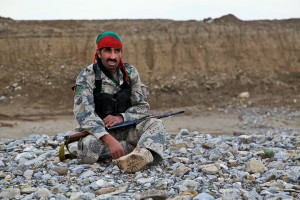
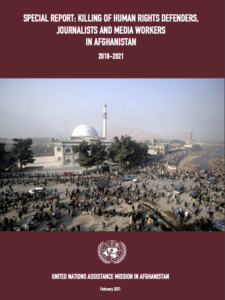 Kabul: No fewer than 11 human rights defenders and media workers were killed in targeted attacks in Afghanistan from the September 12, 2020 start of Afghanistan peace negotiations (APN) in Doha (Qatar) through to January 31, 2021. This trend, combined with the absence of claims of responsibility, has had a chilling impact on civil society, resulting in many human rights defenders, journalists and media workers seeking to leave Afghanistan.
Kabul: No fewer than 11 human rights defenders and media workers were killed in targeted attacks in Afghanistan from the September 12, 2020 start of Afghanistan peace negotiations (APN) in Doha (Qatar) through to January 31, 2021. This trend, combined with the absence of claims of responsibility, has had a chilling impact on civil society, resulting in many human rights defenders, journalists and media workers seeking to leave Afghanistan.
Human rights and media space has contracted as a result, with many professionals exercising self-censorship in their work, quitting their jobs, and leaving their homes and communities with hopes it will improve their safety. Many, including high profile personalities, have fled the country. The killings have had the broader impact across society of also diminishing expectations around efforts towards peace.
A new report issued today by the United Nations Assistance Mission in Afghanistan (UNAMA) analyses data and trends connected to the killings from January 1, 2018 to January 31, 2021. It traces the changing patterns of attacks on these key sectors of civil society and provides recommendations. According to the report, the opening of APN has failed to produce the long desired decrease of violence, dampening the optimistic expectations of many Afghans.
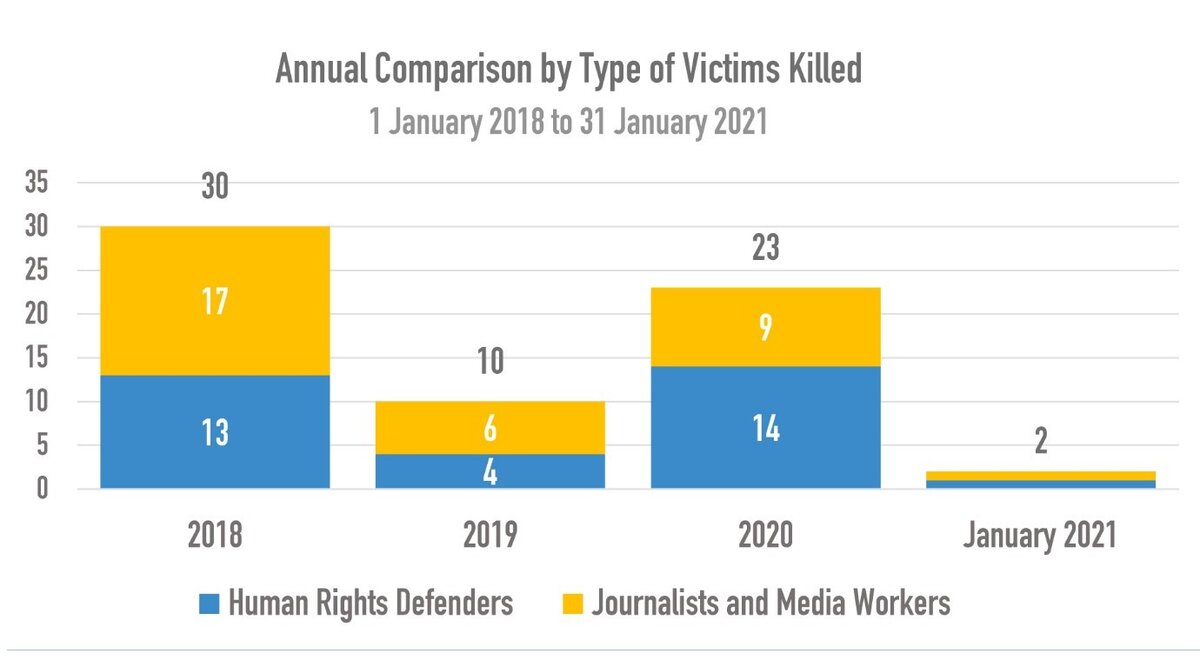
The report underscores the fact that due to the nature of their work, human rights defenders, journalists and media workers have been for many years exposed to different types of risks in Afghanistan. Working to provide timely information to the population of Afghanistan, exposing a range of issues (including violations of international humanitarian law and human rights law), they are far too often exposed to threats, intimidation, harassment, surveillance, arbitrary detention.
In the past months, a spate of intentional, premeditated and deliberate targeting of human rights defenders, journalists and media workers was recorded in Afghanistan, with a clear objective of silencing specific individuals by killing them, while sending a chilling message to the broader community.
Many human rights defenders and journalists fled Afghanistan, and many others were seeking to do so. In January 2021, the Human Rights Defenders’ Committee of Afghanistan received 31 new applications for support from human rights defenders at risk, of which ten were from women. This marked a sharp increase compared to the seven applications received in the period from September to December 2020. The situation of women human rights defenders and journalists remains of particular concern, the report says.
“The Afghan people need and deserve a flourishing civic space – a society where people can think, write and voice their views openly, without fear,” said Deborah Lyons, the Secretary-General’s Special Representative for Afghanistan. “The voices of human rights defenders and the media are critical for any open and decent society. At a time when dialogue and an end to the conflict through talks and political settlement should be the focus, the voices from human rights and the media need to be heard more than ever before, instead they are being silenced,” said the envoy, who is also head of UNAMA.
Attacks against representatives of the human rights and media sectors in Afghanistan are not a new development, but, as the report documents, there has been a distinct change in the type of killings. The findings of the report highlight that in 2018 the leading source of casualties among both human rights defenders and journalists were attacks by the Islamic State in the Levant-Khorasan-Province (ISIL-KP) involving the use of improvised explosive devices (IEDs) aimed at maximising casualties, though not necessarily through attacks directly targeting human rights defenders or journalists. At that time, the greatest risk seemed to be of incidental harm while reporting on or working with those targeted. In 2019, the number of casualties decreased; however, killing became an increasingly common tactic.
In 2020, this trend continued and reached a peak in the final months of the year, after the start of the APN. Before the start of the APN, ten human rights defenders were killed between 1 January and 11 September 2020 in various Afghan provinces. No claim of responsibility was made for almost all killings. Of the ten human rights defenders killed, three of them were killed in attacks involving the use of IEDs attached to vehicles (including one woman: Fatima Khalil, killed together with an Afghanistan Independent Human Rights Commission driver, Ahmad Jawed Folad). Five human rights defenders were shot and killed by gunmen. Two were abducted and later found dead. Three out of ten had been previously threatened by Taliban members. Four journalists and media workers were killed between 1 January and 11 September 2020. ISIL-KP claimed responsibility for an attack against a Khurshid TV minivan involving the use of an IED placed on the roadside. One attack remained unclaimed. One journalist was killed by a stray bullet fired by the police during a clash with protesters in Ghor.
The most recent wave, that of intentional, premeditated and deliberate targeting of individuals with perpetrators remaining anonymous contrasts to previous years. Then, such deaths were mainly caused by the proximity of individuals to attacks by organised armed groups, mainly the ISIL-KP, involving the use of improvised explosive devices.
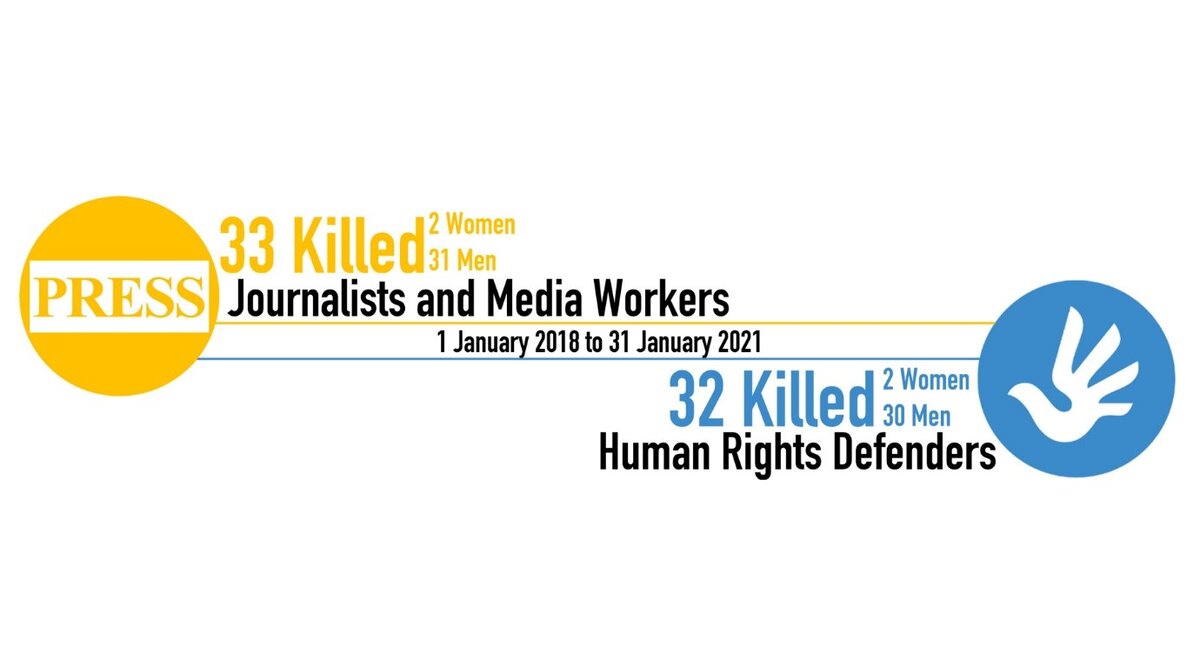
The report records a total of 65 human rights defenders and media professionals killed in the period from 1 January 2018 – 31 January 2021, 32 from the human rights sector and 33 from the media. Of these, 11 (five human rights defenders and six media) were killed in the four-month period from 1 October 2020 – 31 January 2021 alone.
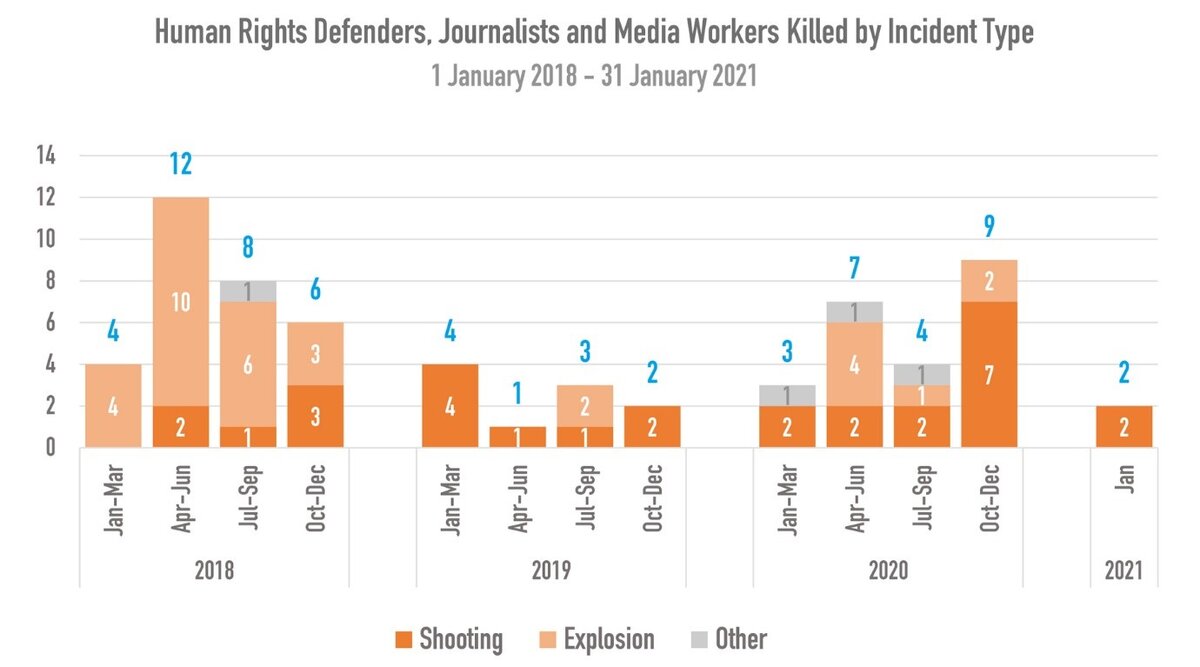
The report notes that as they work to provide timely information to the population of Afghanistan on a range of issues (including violations of international humanitarian law and human rights law), human rights defenders, journalists and media workers are far too often exposed to threats, intimidation, harassment, surveillance or arbitrary detention.
The report underlines that all actors have an important role to play in preventing such killings and intimidation, promoting accountability and preventing impunity. Investigations into killings must be independent, impartial, prompt, thorough, effective, credible and transparent. The prosecution of suspected perpetrators should strictly follow due process and fair trial standards. The use of charged rhetoric against the role of civil society and the media, threats or actions taken against whistleblowers, and the circulation of “target lists” all contribute to perpetuating the conditions in which civic space can only shrink further and exacerbate the unsettling effect on the population, especially human rights defenders and media professionals.
A series of recommendations to both state and non-state actors are contained in the report:
The Government of Afghanistan
- Operationalise an effective and cooperative national protection mechanism, building on the recent establishment of the Joint Commission for the Protection of Human Rights Defenders under the leadership of the Second Vice President of Afghanistan.
- Put in place an adequate preventive framework, including special protective and proactive security measures for human rights defenders, journalists and media workers subject to threats or other types of intimidation.
- Ensure that human rights defenders, journalists and media workers enjoy their legitimate rights to life, freedom of association, freedom of expression and access to information, as well as other fundamental freedoms, without fear of reprisal or attack.
- Counter impunity, including by conducting independent, impartial, prompt, thorough, effective, credible and transparent investigations into killings.
- Promote genuine accountability, including by prosecuting suspected perpetrators of targeted attacks strictly following international due process and fair trial standards.
- Protect and promote civic space, including refraining from adopting restrictive laws on freedom of association and freedom of expression, as well as avoiding a public discourse where civic space is unnecessarily challenged or targeted.
Non-state actors
- Cease all killings of human rights defenders, journalists and media workers, in accordance with international human rights and humanitarian law.
The Taliban
- Condemn at the leadership level killings of human rights defenders, journalists and media workers.
- Investigate cases where Taliban members are alleged to have been involved and hold to account Taliban members that order or implement the killings of human rights defenders, journalists and media workers.
- Adopt, publicize and enforce policies that prohibit the killings of human rights defenders, journalists and media workers.
- Repel existing policies (and refrain from adopting new ones) limiting civic space, including restrictions to freedom of association, the work of civil society and humanitarian actors, freedom of expression.
The international community
- Continue condemning the killing of human rights defenders and media professionals, underscoring the importance of the role of human rights defenders and independent media for a unified, sovereign, peaceful and democratic Afghanistan, in line with the Communiqué adopted at the Geneva Conference on Afghanistan on 24 November 2020.
- Continue to engage with human rights defenders, journalists and media workers at risk and increase support to programs that provide security, travel, financial, capacity building and other assistance to them.
– global bihari bureau





